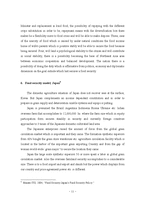[국제식품] 상승하는 세계적인 곡물가격의 분석- 원인과 정책(영문)
 등록일 / 수정일
등록일 / 수정일 페이지 / 형식
페이지 / 형식 자료평가
자료평가 구매가격
구매가격
- 2009.05.25 / 2019.12.24
- 18페이지 /
 doc (MS워드 2003이하)
doc (MS워드 2003이하) - 평가한 분이 없습니다. (구매금액의 3%지급)
- 1,400원
최대 20페이지까지 미리보기 서비스를 제공합니다.
자료평가하면 구매금액의 3%지급!
 1
1 2
2 3
3 4
4 5
5 6
6 7
7 8
8 9
9 10
10 11
11 12
12 13
13 14
14 15
15 16
16 17
17 18
18
추천 연관자료
- 목차
-
Abstract
Ⅰ. Introduction
Ⅱ. Analysis of rising grain prices: Causes and effect
Figure 1. Food prices (Nominal $ Index, Jan 1995=100)
Figure 2. Energy and food prices
Figure 3. Simulated Real Grain Prices, 2000-2007 (US$/metric ton).
Ⅲ. How to settle the problem: Government’s direct policy
Figure 4. Anticipation of a rise in price (US$/metric ton)
1. Short-term tax policy
2. Long-term policies
Figure 5. Supply of non-GMO grains from Brazil (Estimated quantity)
Ⅳ. Indirect policy mechanism
1. Step down import barriers
2. Introduce future market
3. Investing and supporting foreign agriculture industry.
4. Emphasizing our opinion on food security
5. Security of the food security
6. Food security model; Japan
Ⅴ. Conclusion and suggestion
References
- 본문내용
-
Abstract
High price of main grains is recent issue in the global market. International price of main grains has risen since 2007. High price of main grain becomes serious problem not regionally but in global. Then policy for stabilizing the situation will be dealt with in this paper. On the supply side, low stocks of world grains affect to world grain prices. Escalating energy prices is also cause of rising grain prices. On the demand side, increased bio-fuel production has contributed to the rise in food prices. US dollars encourage grain speculationAs short-term direct policy, it needs bestowing a favor on the tax system. It is necessary to improve our own agricultural system in long-term direct policy. In indirect policy mechanism; (1) Step down import barriers, (2) Introduce future market,(3) Investing and supporting foreign agriculture industry, (4) Emphasizing our opinion on food security, (5) Security of the food security, (6) Food security model; Japan. Korean situation is very ambiguous when we talk about Korean agriculture situation in the era of agflation. It is needed to rebuild national food economies
Keywords: Grain Prices, Policy, Agflation
Ⅰ. Introduction
High price of main grains is recent issue in the global market. International price of main grains has risen since 2007. In average, price of wheat has been risen by about 140%, 56% rise in case of corn price and the price of soybean has become twice as much in march, 2008 compared to the original price in 2006.
High price of main grain becomes serious problem not regionally but in global. World reserve for grain is 14.7 % which is the lowest ratio since 1974. Developing countries’ situation is worse than developed countries. Higher basic grain price gives more burdens to livelihood, because it affects prices of other commodities. The ratio of grain price in consumption expenditure is 65 % in developing countries, while only 10~20 % in developed countries. Moreover, high grain price causes social insecurity. For example, citizens came out and demonstrated against rising price of tortilla, which is staple food of Mexico, made from corn.
Korea is not an exception from this situation. Korean situation is also vulnerable because of its low self sufficiency rate in agriculture. In other word, Korea is highly dependent on grain imports whose rate is 75 % in the year of 2008. It causes rise of cost for dairy products and gives burden to the consumers. Korea needs to find ways for keeping food security.
Unfortunately, this situation is predicted to continue for a while, as there are several reasons of price rising. Basic reason is unbalance between supply and demand of grain. This paper will find out some reasons of this situation in both supply and demand aspects. Then policy for stabilizing the situation will be dealt with in this paper.
Both direct policy and indirect policy mechanism will be considered. We will draw a conclusion to find out what will be the best solution to the world grain crisis.
Ⅱ. Analysis of rising grain prices: Causes and effect
Food prices have risen since 2000s and particularly 2006 (Fig. 1.). Soaring food
- 참고문헌
-
The Development Prospects Group
http://econ.worldbank.org/WBSITE/EXTERNAL/EXTDEC/EXTDECPROSPECTS/0%2C%2CcontentMDK%3A20267500~menuPK%3A476908~pagePK%3A64165401~piPK%3A64165026~theSitePK%3A476883%2C00.html, May-30-2008
Helen Thomas, “The Agflation outlook”, May 2008
Ito, Shoichi: World Food Statistics and Graphics, January 2008:
http://worldfood.apionet.or.jp
Mark W. Rosegrant, “Biofuels and Grain Prices: Impcats and Policy Response”, May 2008
Overseas Development Institute, “Rising food prices: a global crisis”, Briefing Paper, April, 2008
PREM, ARD and DEC, “Rising food prices: Policy options and World Bank response”
Shane Oliver, “Inflation, Agflation, Stagflation – What It Means for Investors”, March 2008
USDA,” World Agricultural Supply and Demand Estimates”, May 9, 2008
FAO, ”Crop Prospects and Food situation” , 2008
OECD, In Süddeutsche Zeitung, 15-4-2008
LEMONDE.FR with AFP 24-02-2008
Biofuel News 20-3-2008
http://www.checkbiotech.org/green_News_Biof
자료평가
-
아직 평가한 내용이 없습니다.
오늘 본 자료
더보기

최근 판매 자료
- WirelessLan무선랜
- 무선랜 WirelessLAN2
- 중금속 - 중금속 종류, 체내에 축적되는 경로, 피해현상
- 파이썬의 활용에 대해서
- 영상제작실무 / 유튜브기획안 (영상제작예산안, 영상구성안, 촬영스케줄표, 유튜브구성)
- [금오공대 A+] 일물실 음파의 맥놀이 예비보고서 + 결과보고서
- [네트워크 프로토콜 A+] 이더넷(ethernet)의 역사와 미래
- [부산대] 고체의 비열
- 자동차섀시공학 - 자동차 종류, 구동방식, 한국 자동차 산업의 역사와 현황 및 향후 전망
- [자동차기술] Front Wheel Drive & Rear Wheel Drive(전륜구동 방식과 후륜구동 방식]의 비교와 분석
저작권 관련 사항 정보 및 게시물 내용의 진실성에 대하여 레포트샵은 보증하지 아니하며, 해당 정보 및 게시물의 저작권과 기타 법적 책임은 자료 등록자에게 있습니다. 위 정보 및 게시물 내용의 불법적 이용, 무단 전재·배포는 금지됩니다. 저작권침해, 명예훼손 등 분쟁요소 발견시 고객센터에 신고해 주시기 바랍니다.









